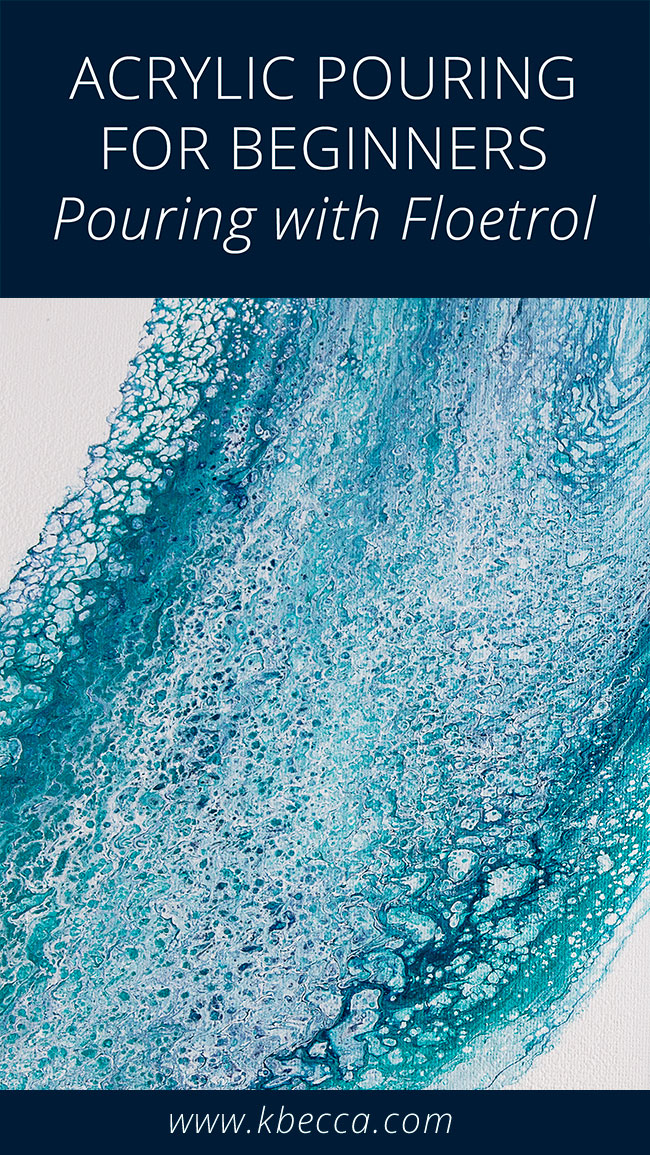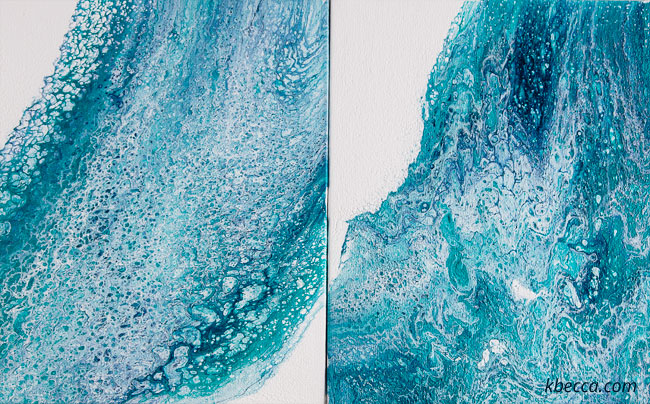
Finally, Floetrol! Floetrol is one of the most popular pouring mediums for acrylic pouring, and in today’s acrylic pouring for beginners video I’ll show you how my very first Floetrol pour went. I also used silicone oil, which created lots of little cells throughout my paintings.
I had enough paint / pouring medium mixed for two paintings. The first painting didn’t turn out quite how I wanted, but as it dried I really liked the texture that the cells created throughout the painting, and I loved the darker areas of color along either side of the whiter center area. The second painting had larger areas of the blue colors, which I loved, and I also created an area of negative space on the top left of the painting with white paint. I like the sharp cutoff between the solid area of white and the blues. It creates great contrast and makes the colors stand out even more.

Check out the video below to learn how to do paint pouring with Floetrol as a pouring medium:
Supplies Used in This Project
The following supply list contains affiliate links. I make a small commission if you purchase through these links, and I really appreciate it if you do!
Husky Plastic Sheeting (or a large garbage bag / old newspapers / a bunch of plastic grocery bags / a painter’s dropcloth)
Foil Cookie Tray (to catch most of the excess paint as it runs off the edges of the painting – I purchased a set of 2 for $1.00 at the dollar store)
Vinyl / Nitrile Gloves (if you don’t want to be cleaning acrylic paint from under your fingernails for days, then use gloves – I buy mine by the box at Walmart in the cleaning supplies aisle)
Acrylic Craft Paints (in the video, I used DecoArt Crafters Acrylic White, Martha Stewart Summer Haze, Folk Art Aqua, and a mix of Americana Ultramarine Blue and Midnight blue craft paints)
Floetrol (I used a ratio of 1:1 Floetrol to paint, but if you have a thicker paint, you might want to go to 60/40 Floetrol to paint or add a little bit of water to thin things out to a good consistency)
Plastic Cups (to hold the paint / pouring medium mixture – you can use any small plastic cups for this, or you can save yogurt containers or even plastic cat food containers and use those)
Wood Craft Sticks (to stir the paint / pouring medium mixture – I picked up a package of 100 for $1.00 at the dollar store, and once the paint is completely dry on them, you can reuse them)
Art Alternatives 8×10 Canvas Panels
Plastic Shot Glasses (to raise the canvas off of the work surface so the paint can flow off the edges after you pour – I bought a package of 24 plastic shot glasses for $1.00 at the dollar store, but you can use food service containers, plastic yogurt containers, cat food containers, or even a small box under the canvas)
Spot On 100% Silicone Treadmill Belt Lubricant to create cells in acrylic pour paintings. I used about 20 drops / 1/8 teaspoon to about 3 Tablespoons of the Floetrol/paint mixture.


Thankyou that was the easiest recipe to follow and commit to memory
I really like your video. It’s very easy to follow – nice speaking voice – good directions, not too much, it moves along nicely. Thank you.
Just a question – I wanted to use silicone oil in my first project, but heard that one can’t varnish it afterward. What’s the story on that?
Thanks again,
Gabriele
very nice
Is it a no-no to use Floetrol and add the silicone drops in too?
I used Elmer’s glue and silicone drops for my first 4 paintings. They had cells and lacing and they were very nice for a beginner. I tried my next canvas using only the Floetrol as a medium. I got no cells and I could barely see a few spots where lacing tried to take hold. A heat gun and a torch didn’t help bring out any cells. I can’t figure out what I did wrong.
What do you think happened?